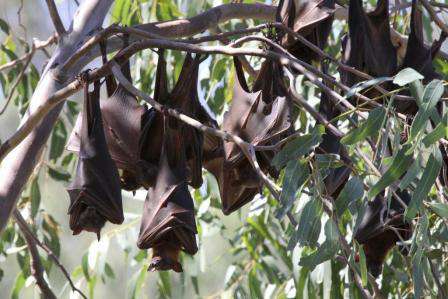Even the native wildlife has been finding the heat hard to beat as this picture sent to us by the Goulburn Broken Catchment Management Authority (CMA) clearly shows.
Even the native wildlife has been finding the heat hard to beat as this picture sent to us by the Goulburn Broken Catchment Management Authority (CMA) clearly shows.

Goulburn Broken CMA Land and Biodiversity manager Steve Wilson snapped these flying foxes hanging around staying cool while in Numurkah recently.
“For many years now a small fluctuating colony of both the larger Grey-headed flying fox (Pteropus poliocephalus) and little flying fox (P. scapulatus) has been roosting by day in the large eucalypts along Broken Creek opposite the local pool complex and park,” Mr Wilson said.
“While some Numurkah residents may have spotted the flying foxes moving across the skyline, a lot of people may not even be aware of them.”
Mr Wilson said flying foxes, the largest of all bats, were important pollinators of native plants given their diet of nectar, pollen, blossom and fruit because of their wide foraging range (up to 40km).
“They’re also very social - they love each other’s company and any resting colony is busy with noise and constant chatter,” Mr Wilson said.
Other interesting facts about flying foxes include:
• unlike bats, flying foxes don’t use echo-location to locate food; instead they rely on a strong sense of smell and keen eyesight;
• like us flying foxes do get thirsty, and will fly across water bodies to scoop up a drink, even occasionally dunking themselves to really get cool;
• across Australia flying foxes are moving into urban areas in search of food and shelter, usually as a result of destruction of habitat;
• flying foxes have a low breeding rate, with females giving birth to only one young per year
• as native wildlife they are a protected species with grey-headed flying fox listed as vulnerable to extinction.
“These unusual animals are interesting and contribute to the health of our native habitats,” Mr Wilson said.
“Why not head to Numurkah, which is great little town, with the kid and some binoculars and enjoy the sights and sounds of an active flying fox colony,” Mr Wilson said.
If you’re keen to find out more about protecting and enhancing habitat for flying foxes and other wildlife, contact your local Landcare or Conservation Management Network.